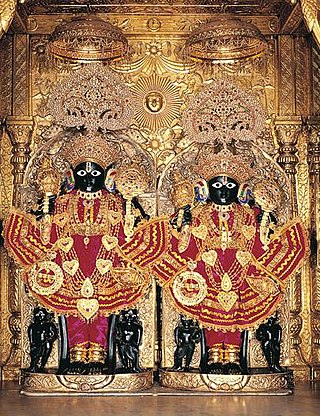Nirvana is a concept in the Indian religions of Buddhism, Hinduism, Jainism, and Sikhism that refers to the extinguishing of the passions which is the ultimate state of salvational release and the liberation from duḥkha ('suffering') and saṃsāra, the cycle of birth and rebirth.

Prajapati is a Vedic deity of Hinduism and he is a form of Brahma, the creator god.
Moksha, also called vimoksha, vimukti, and mukti, is a term in Hinduism, Buddhism, Jainism, and Sikhism for various forms of emancipation, liberation, nirvana, or release. In its soteriological and eschatological senses, it refers to freedom from saṃsāra, the cycle of death and rebirth. In its epistemological and psychological senses, moksha is freedom from ignorance: self-realization, self-actualization and self-knowledge.
Brahmacharya is a concept within Indian religions that literally means "conduct consistent with Brahman" or "on the path of Brahman". Brahmacharya, a discipline of controlling the senses, is seen as a way to liberation. Though sexual restraint is a part of brahmacharya, brahmacharya encompasses all striving toward a passionless state.
Paramatman or Paramātmā is the absolute Atman, or supreme Self, in various philosophies such as the Vedanta and Yoga schools in Hindu theology, as well as other Indian religions such as Sikhism. Paramatman is the "Primordial Self" or the "Self Beyond" who is spiritually identical with the absolute and ultimate reality. Selflessness is the attribute of Paramatman, where all personality/individuality vanishes.
Saccidānanda is an epithet and description for the subjective experience of the ultimate unchanging reality, called Brahman, in certain branches of Hindu philosophy, especially Vedanta. It represents "existence, consciousness, and bliss" or "truth, consciousness, bliss".

Naranarayana, also rendered Nara-Narayana, is a Hindu duo of sage-brothers. Generally regarded to be the partial-incarnation (aṃśa-avatara) of the preserver deity, Vishnu, on earth, Nara-Narayana are described to be the sons of Dharma and Ahimsa.

The Katha Upanishad, is an ancient Hindu text and one of the mukhya (primary) Upanishads, embedded in the last eight short sections of the Kaṭha school of the Krishna Yajurveda. It is also known as Kāṭhaka Upanishad, and is listed as number 3 in the Muktika canon of 108 Upanishads.

The Mudgala Upanishad is a Sanskrit text and a major Upanishad of Hinduism. It is classified as a Samanya Upanishad and attached to the Rigveda.

Yama, also known as Kāla and Dharmarāja, is the Hindu god of death and justice, responsible for the dispensation of law and punishment of sinners in his abode, Naraka. He is often identified with Dharmadeva, the personification of Dharma, though the two deities have different origins and myths.
Maitreyi is an Indian philosopher who lived during the later Vedic period in ancient India. She is mentioned in the Brihadaranyaka Upanishad as one of two wives of the Vedic sage Yajnavalkya; she is estimated to have lived around the 8th century BCE. In the Hindu epic Mahabharata and the Gṛhyasūtras, however, Maitreyi is described as an Advaita philosopher who never married. In ancient Sanskrit literature, she is known as a brahmavadini.

Marichi or Mareechi or Marishi is the mind-born son of Brahma, and one of the Saptarishi in Hindu mythology. He is also the father of Kashyapa, and the grandfather of the devas and the asuras.

In Hinduism, Brahman connotes the highest universal principle, the Ultimate Reality of the universe. In major schools of Hindu philosophy, it is the non-physical, efficient, formal and final cause of all that exists. It is the pervasive, infinite, eternal truth, consciousness and bliss which does not change, yet is the cause of all changes. Brahman as a metaphysical concept refers to the single binding unity behind diversity in all that exists.
Ratha Kalpana is a metaphor used in Hindu scriptures to describe the relationship between the senses, mind, intellect and the Self. The metaphor was first used in the Katha Upanishad and is thought to have inspired similar descriptions in the Bhagavad Gita, the Dhammapada and Plato's Phaedrus. Gerald James Larson, a scholar of Indian philosophies, believes that the chariot metaphor contains one of the earliest references to ideas and terminology of the Indian philosophical school Samkhya.

The Tejobindu Upanishad is a minor Upanishad in the corpus of Upanishadic texts of Hinduism. It is one of the five Bindu Upanishads, all attached to the Atharvaveda, and one of twenty Yoga Upanishads in the four Vedas.
Brahma Upanishad is an ancient Sanskrit text and one of the minor Upanishads of Hinduism. It is among the 32 Upanishads attached to the Krishna Yajurveda, and classified as one of the 19 Sannyasa Upanishads.

The Kaivalya Upanishad is an ancient Sanskrit text and one of the minor Upanishads of Hinduism. It is classified as a Shaiva Upanishad, and survives into modern times in two versions, one attached to the Krishna Yajurveda and other attached to the Atharvaveda. It is, as an Upanishad, a part of the corpus of Vedanta literature collection that presents the philosophical concepts of Hinduism.

Varaha Upanishad is a minor Upanishad of Hinduism composed between the 13th and 16th centuries CE. Composed in Sanskrit, it is listed as one of the 32 Krishna Yajurveda Upanishads, and classified as one of 20 Yoga Upanishads.

The Paingala Upanishad is an early medieval era Sanskrit text and is one of the general Upanishads of Hinduism. It is one of the 22 Samanya (general) Upanishads, and its manuscripts survive in modern times in two versions. The shorter version of the manuscript is found attached to the Atharvaveda, while the longer version is attached to the Shukla Yajurveda. It presents a syncretic view of Samkhya and Vedanta schools of Hindu philosophy.

The Niralamba Upanishad is a Sanskrit text and is one of the 22 Samanya (general) Upanishads of Hinduism. The text, along with the Sarvasara Upanishad, is one of two dedicated glossaries embedded inside the collection of ancient and medieval era 108 Upanishads, on 29 basic concepts of Hindu philosophy.













